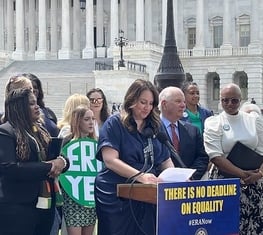As a nonpartisan organization, the League of Women Voters offers this unbiased information to voters seeking to learn more about the impeachment process.
The BasicsImpeachment does not mean removal from office. It is the process of bringing charges against a sitting member of the government, including the President, Vice President, and other federal “civil officers.” Impeachable offenses for public officials are outlined in the Constitution as "Treason, Bribery, or other high Crimes and Misdemeanors.”
The process involves three steps, though the process may end at any one of the three steps, depending on how the body in question votes:
-
An investigation in House of Representatives committees
-
A vote of the House to pass articles of impeachment
-
A trial and vote in the Senate to convict the official
Impeachment proceedings can be initiated by any member of the House. Once this process is initiated, an investigation involving all relevant committees, which is usually overseen by the House Judiciary Committee, takes place.
Committee Investigations
The committee investigation is what determines if the public official in question has engaged in one of the three offenses (bribery, treason, or high crimes and misdemeanors) outlined in the Constitution. There are three House committees with investigatory powers: Foreign Affairs, Intelligence, and Oversight.
Articles of Impeachment
Following the investigation, the Judiciary Committee determines through a majority vote if the public official has engaged in an impeachable offense. If so, the committee then sets forth the Articles of Impeachment, which detail the specific allegations of misconduct in the form of a resolution. The committee might find that there are no grounds for impeachment during the investigation and may choose not to generate a resolution.
The House Votes
The House votes on the resolution created by the committee. They may vote on the resolution as a whole, or on the specific articles. A simple majority is needed to pass the resolution and move forward with the impeachment process. If a simple majority is reached in the House, they will then report back to the Senate with their findings. If a majority cannot be reached, then there is no impeachment and the process does not move forward to the Senate.
In the SenateThe House sends resolution(s) passed to the Senate. This is called the presentation of the articles of impeachment. Once received, the Senate issues a “writ of summons” to the official being impeached calling them to answer to the articles. The accused official may appear in person or through an attorney on a set date in front of the Senate. If the official does not appear, the proceedings will move forward as if they pled “not guilty.” The official can also contest and say there are no sufficient grounds for impeachment.
Trial Procedure
The Senate sets a date for the trial. If this is a trial for the President, then the Chief Justice of the Supreme Court presides over the trial. For all other impeachment hearings involving civil officers, the hearing is conducted by a Committee Chair or the President of the Senate.
During this time, a group of Senators or the full Senate takes evidence, hears testimony, conducts questioning, and cross-examines the witnesses. During the trial, House managers or their counsel and the counsel of the respondent give opening remarks and present ongoing arguments outlining the charges. Evidence is presented and witnesses are examined by both sides.
Judgment and Conviction
When the trial concludes, the Senate meets in a closed session to deliberate. Following deliberation, the Senate votes on conviction for the articles of impeachment in an open session with yeas and nays recorded on each article individually. A conviction on an article requires a two-thirds majority of those present.
If the public official is convicted on at least one article of impeachment, the presiding officer announces the conviction and removal of the official from their office. The Senate can then decide if this person will be barred from public office permanently. If there is less than a two-thirds majority to convict on any of the articles of impeachment, then the accused official is acquitted and remains in office.
Where does the League stand on impeachment?For nearly 100 years, the League of Women Voters has stood for accountability and transparency in government.
The League’s carefully crafted and diligently honed positions on good government operations are approved by delegate members from Leagues all over the country. The following positions are included in the League of Women Voters official positions:
-
“The League of Women Voters of the United States believes that presidential power should be exercised within the constitutional framework of a dynamic balance between the executive and legislative branches. Accountability and responsibility to the people require that unnecessary secrecy between the President and Congress be eliminated.”
-
“The League of Women Voters of the United States believes that structures and practices of the U.S. Congress must be characterized by openness, accountability, representativeness, decision-making capability, and effective performance.”
Overall, the League of Women Voters believes that government officials should work in cooperation across branches of government and that they should conduct their work with transparency and accountability to the American people.
Additional ResourcesImpeachment and Removal, Congressional Research Service—October 29, 2015
An Overview of the Impeachment Process, Congressional Research Service—April 20, 2005
Sign Up For Email
Keep up with the League. Receive emails to your inbox!
Donate to support our work
to empower voters and defend democracy.





